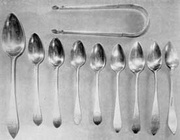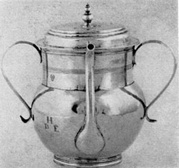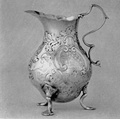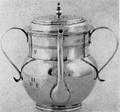Compared to their Colonial neighbors, Vermont silversmiths got a late start. That’s because the first permanent non-Native American settlement in Vermont (Bennington) was not established until 1761, about 140 years after Europeans settled the surrounding areas. Prior to the founding of Bennington, Vermont was the home and hunting ground of the Abenaki, as well as a buffer zone between the French in Canada to the north and the English governing their Colonies to the south.
Despite this disadvantage, or perhaps because of it, some people are drawn to Vermont silver and its unique history. Jonathan Vincent is one such person. Vincent is an architect by training but a collector by passion and lineage—his parents collected, but his handsome and talented son Will, who is a colleague here at CollectorsWeekly.com, claims not to have been bitten yet by the collecting bug. Vincent has scores of Vermont silver spoons, as well as numerous Ukiyo-e woodblock prints, a fine selection of pre-1850 furniture, and a respectable collection of toleware, a type of painted tin. In fact, Vincent is an amateur tinsmith, which probably accounts for his related cache of tinsmithing tools from the mid-19th century.
But Vermont spoons have a special place in Vincent’s heart, in part because he now calls the state home and in part because of their, well, economy. “I had moved from Massachusetts to Vermont for a job,” he remembers, “and I discovered that silver spoons made in Vermont were really inexpensive. They were $7 to $20 apiece, maybe a little more for special pieces, but reasonable and readily available from dealers and at shows. I satisfied my collecting urge by picking up spoons.”
“My wife thinks I have too many spoons. For that matter, I think I have too many spoons.”
What really drew Vincent to Vermont flatware was the history that could be teased out of each piece. “English silver pieces have lots of hallmarks on them,” he says. “The hallmarks tell you where the silver was tested and taxed, the date it was assayed, and often the maker. You can tell a lot about a piece of English silver just by looking at the marks. American silver makers copied the English, but there was no assaying office, no federal tax. Some American silver pieces had faux hallmarks that looked like English marks to give the impression of quality, but those marks were just fakes.”
Within American silver, Vermont silver is unique because of the predominance of spoons. “In the Colonial and post-Colonial era,” he says, “when a young woman married, she would have her dowry, as well as a set of silver teaspoons, tablespoons, and maybe tongs so she could serve tea to visitors. That’s typically what you find today; lots of spoons and ladles and tea items. They survived because they were only used on special occasions.

Top: Ira S. Town worked in Montpelier from about 1825 to 1852. Above: Brinsmaids was a silversmith in Burlington.
“These teaspoons and tea sets were made in lots of little towns in Vermont,” Vincent continues. “From the name of the owner engraved on the front of the handle or the name of the town stamped on the back, you can identify where and approximately when something was made. Some of these towns aren’t big enough to support a Wal-Mart today, but they had their own silversmith back in the 1800s.”
Just about all silver from the late 18th and early 19th centuries, including pieces from Vermont, was made out of coin silver. “Coin silver is any silver that’s made from 90 percent silver and 10 percent copper,” says David Perrin, whose “Coin Silver: Is It a Vermont Mark? A Collector’s Dilemma” is the last word on the subject. “At one point, Mexican and English silver coins were of good enough quality to use as flatware, but I suspect quite a bit of Vermont coin silver was made by starting with pure copper and silver rather than silver coins, although I don’t know that anybody really knows for sure.”

Top: A salt shovel by W. M. Root and Brother of Massachusetts. Above: A sugar shovel from H. M. Nichols of Lyndon Center.
People like Perrin and Vincent naturally use the incised and impressed marks on spoons to identify them, but they also frequently try to dissect a spoon’s design. “Very early on,” says Vincent, “in the 17th century, there was a thing called a trefid spoon. You don’t find those in Vermont, of course, but you can find examples from Massachusetts and New York. It had a rounded bowl and a three-pronged handle. Sometimes the spoon would be set face down on the table so people could admire the engraving and the patterns on the back of the bowl.”
“Some of these towns aren’t big enough to support a Wal-Mart, but they had a silversmith in the 1800s.”
Coffin-handled spoons came later. “Those coffin-ended spoons were typically made between 1800 and 1810,” says Perrin. “Some accounts say they were made to mourn the death of George Washington. I don’t really believe that, but that’s how they’re frequently attributed.”
Another clue is the shape of a spoon’s shoulder, which is the junction between a spoon’s bowl and its handle. “Earlier spoons didn’t have a shoulder,” continues Perrin, “and then around 1800 or 1805, they started to have quite a sharp shoulder. As time went on, by 1820 or so, they had rounded shoulders, and after about 1850, the shoulders of some spoons disappeared again.”

Vermont is not known for hollowware. This coin silver helmet creamer was made by Daniel Bloom Coen of New York.
One thing Vermont was definitely not known for was its hollowware. “Teapots, bowls, and larger items were typically found in the big cities like Boston, Hartford, New York, or Philadelphia,” Vincent says. “People in little Vermont farming towns didn’t have that kind of money, and if they did, they’d go to Boston to buy it. So silver making was strictly tied to the economic fortune of the area, which is why little towns in Vermont like Lyndonville might have one man who made some spoons for the local ladies who were just about to be married, and that was it.”
According to Perrin, there was another reason why Vermont silversmiths stuck to flatware. “Vermont silversmiths were mostly former apprentices from other states such as Connecticut and Massachusetts,” he says. “They needed to find a place where they could make a living without competing with their masters. Vermont offered that, and flatware was relatively easy for these apprentices to make.”
Vincent has spoons by many of these early former apprentices, as well as the silversmiths who came later in the mid-19th century. “The Bailey family was very prominent,” Vincent says. “R. H. Bailey practiced in Woodstock, Bradbury M. Bailey was in Ludlow and then Rutland. I have five teaspoons by him with my wife’s name on them, although they were obviously not made for her at the time. I also have some pieces that were made by Bailey in Woodstock and then marketed by a business associate of his in Boston. Those I didn’t have to buy; I got them from my mother.”

Vincent has traced these six coffin-handled teaspoons from their origins in Connecticut to their settlement in Vermont.
Other histories have required a bit more sleuthing. “I recently bought six American teaspoons,” Vincent says. “All they had on them were the initials of the owner, but with a little bit of research into the town they came from, I discovered that they were probably made in Connecticut in the 1790s for the wife of one of the original founders of a town in Vermont. I can’t prove it, but I have a strong suspicion they were made for her marriage in Connecticut just before she moved to Vermont with her husband, where she stayed the rest of her life. That’s the kind of thing I like to do.”
These days, Vincent goes to three or four auctions a month looking for pieces to fill out his collection. “They’re still not very expensive,” he says, “and they’re light enough in weight that people aren’t melting them down that often. That’s the problem with collectible silver nowadays,” he adds. “If it’s not by a famous maker like Tiffany or if it’s not a special or finely made piece, a lot of times people are buying the pieces just to sell them for their raw silver value, which is really sad because you’re losing a lot of American history.”
In a way, Vincent is protecting Vermont’s history by collecting it. “My wife thinks I have too many spoons,” he admits. “For that matter, I think I have too many spoons. I definitely have enough for all three of our kids. They could each give a big tea party and still have plenty of spoons.”
(All photos courtesy Jonathan Vincent. To order a copy of David Perrin’s book, visit the Vermont Historical Society)



 The Drowne Silversmiths of Portsmouth
The Drowne Silversmiths of Portsmouth
 Paul Revere, His Craftsmanship and Time
Paul Revere, His Craftsmanship and Time The Drowne Silversmiths of Portsmouth
The Drowne Silversmiths of Portsmouth Small But Useful American Silver
Small But Useful American Silver Sterling Silver FlatwareWhen it comes to antique sterling silver flatware, age is not everything. F…
Sterling Silver FlatwareWhen it comes to antique sterling silver flatware, age is not everything. F… Silver SpoonsAs the oldest type of flatware, spoons have existed in some form or another…
Silver SpoonsAs the oldest type of flatware, spoons have existed in some form or another… SilverHolding a piece of sterling silver flatware in the palm of the hand is like…
SilverHolding a piece of sterling silver flatware in the palm of the hand is like… Mari Tepper: Laying it on the Line
Mari Tepper: Laying it on the Line Nice Ice: Valerie Hammond on the Genteel Charm of Vintage Canadian Costume Jewelry
Nice Ice: Valerie Hammond on the Genteel Charm of Vintage Canadian Costume Jewelry How Jim Heimann Got Crazy for California Architecture
How Jim Heimann Got Crazy for California Architecture Modernist Man: Jock Peters May Be the Most Influential Architect You've Never Heard Of
Modernist Man: Jock Peters May Be the Most Influential Architect You've Never Heard Of Meet Cute: Were Kokeshi Dolls the Models for Hello Kitty, Pokemon, and Be@rbrick?
Meet Cute: Were Kokeshi Dolls the Models for Hello Kitty, Pokemon, and Be@rbrick? When the King of Comedy Posters Set His Surreal Sights on the World of Rock 'n' Roll
When the King of Comedy Posters Set His Surreal Sights on the World of Rock 'n' Roll How One Artist Makes New Art From Old Coloring Books and Found Photos
How One Artist Makes New Art From Old Coloring Books and Found Photos Say Cheese! How Bad Photography Has Changed Our Definition of Good Pictures
Say Cheese! How Bad Photography Has Changed Our Definition of Good Pictures Middle Earthenware: One Family's Quest to Reclaim Its Place in British Pottery History
Middle Earthenware: One Family's Quest to Reclaim Its Place in British Pottery History Fancy Fowl: How an Evil Sea Captain and a Beloved Queen Made the World Crave KFC
Fancy Fowl: How an Evil Sea Captain and a Beloved Queen Made the World Crave KFC
I have a spoon that looks like the spoons shown on silver spoon site by Ben Marks and Joanna Mangan. It has the word coin on the back and also the name L. T Welles. I wondered if you could tell me anything about it.
I have a spoon exactly like the first one in the second picture. Back has w.m. Root with a symbol. Another name —sfield can’t make out the first three letters. Front handle engraved in old English script M L Barker. I really don’t want to melt this down looking for someone who would purchase and keep the history alive.
I have 3 teaspoons made by H M Nicholas with Initals {L J J} I believe that is Lovisa Jane Johnson (1831 – 1915) my husbands relative. She was born in Newark, VT; married George Edson Powers and they lived in Willoughby and Caledonia, VT. Thanks for the history lesson, I was going to sell them, just might keep them and print your article.
Hello I have 2 spoons on Collectors Weekly, one with shoulders, it is marked F H CHASE and Ft Fairfield The other is CAM IIL Feel free to contact me with any infor mation on these my call name on Collector’s Weekly is toracat you may see good photos at this site. I am sure these are coin and the one with shoulders is Vermont! thanks Don remember toracat on Col. Weekly
Thanks for this information. i do have a question. I have a spoon that looks like the first spoon in the first picture at the top of this article. On the back by the bowl it is marked Sutherland followed by what looks close to an M. If possible I would like to know value and history. I found this spoon in Canada where I live. Thank you!
I have a smaller silver teaspoon that has a strange shaped cresent moon followed by a crown followed by 800 H&D. Can anyone tell me something about it?
I have a sterling silver sugar spoon with leaves and grapes on handle and engraved with the name Anna W. Graham on back of spoon bowl. Any significance?
I have 2 serving spoons marked R.H Bailey and Woodstock with the monogram L D. They have the rounded shoulders and end of handle is flat not like those in the picture that have a slight build up on the top center at end of handle. How old are these and do you have any idea who LD was.
I found what I believe is a salt spoon from s. kirk. Someone put a small tag on it that says Baltimore 11oz. Under the paper covering the oz letters is a piece of what looks like silver patch. The “patch” is flush to the spoon handle. I tried scrapping it with a finger nail and it feels flat to the handle. It is 4″ long base of the handle is 1/2″ wide and narrows to 1/4” with a shoulder just below the dish, dish of spoon is slightly oblong and an 1″ wide. The narrow part of the handle is curved up so the spoon does not lay flat. What I need to know is this a salt spoon and why the tag is partially covered. Also what is it worth.
I HAVE A TYPICAL NE STYLE TSP. WITH ROUNDED SHOULDERS. IT IS MARKED INCUSE H. R.Taylor. AN ANYONE ATTRIBUTE IT?? THANX,BOB GILL
I have a set of 12 delicate spoons with twisted handles. On the back is a diamond shape with the work “Liquid” in the middle…do you know what that means? Thank you!
Have small sugar spoon with crown atop crest. Crest depicts stork standing straight and on one leg with snake in beak. Banner below crest “s GRAVENHAGE”. LIRO in polygon stamped on back. Can anyone please help me with info on where and when this piece was made? Thanks
I have several old spoons that I am sure are Vermont silver. They have a monogram….the first letter is in script followed by two more letters. Is there somewhere I might send a photo and ask you to identify the first letter. Some in our family think the letter is F and others a J. Can you help, please.
Thanks, Janice Ariola. Phoenix AZ
I have an R.H. Bailey spoon that sounds like the same kind as Mary Lou P.’s in the comments above. It was given to me as a wedding gift by an antique dealer from Woodstock, my home town. The monogram is MRB. I’d love to know how old it is.
I have a very ornate sterling silver spoon. The front on the spoon has QUARRY BARRE and on the handle it says VERMONT. The back says sterling with 925 over 1000 (925_1000). It’s superbly ornate and it’s been in my family since I can remember. My grandfather cherished this soon and left it to me when he passed over 50 years ago. I’d appreciate it someone could help me. Thank you.
I found in my pasture a tiny spoon (by graves need old house place)marked Nobility Plate, has four crowns. It is approx 4″ long. Is it of any value? I was unable to find a spoon that small. It looks like a toy or a baby spoon. Any info?
I have what looks to be a tea or dessert spoon as pictured in your article. It appears fragile and thin and is torn or cracked on the bowl. It is monogramed on the front which I believe to be “J T T”. It is engraved “H. R. TAYLOR” ON THE BACK. No other marks.
Could this be a “Vermont Spoon”?
I also collect Vermont Coin Silver and I have around 200 in my collection!!! I also collect silver made by Silver Smith, who were connection to the republic of Vermont copper coins that were minted in Rupert, Vermont. They hired several Silversmiths from New York City to come up and create the dies for the Republic of Vermont copper coins and I have several pieces that were made by those guys.